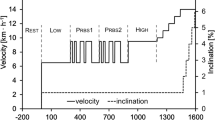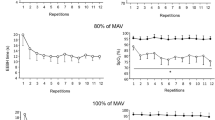Abstract
The present study was performed to examine whether or not the ventilatory response at the onset of voluntary exercise and passive movement in endurance runners is the same as in untrained subjects. Twelve long-distance runners belonging to the varsity athletic club and 13 untrained subjects of our university participated as subjects in this study. Maximum oxygen uptake was significantly higher in the endurance runner group [mean (SD) 70.8 (4.7) ml · kg−1 · min−1] than in the untrained group [49.8 (6.3) ml · kg−1 · min−1]. Cardiorespiratory responses during voluntary exercise and passive movement of alternate flexion-extension of the right and left legs for about 15 s at a frequency of about 60 rpm, were determined by means of breath-by-breath techniques. Minute inspiratory ventilation (V˙ I), tidal volume (V T), respiratory frequency (f b), cardiac output (Q˙ c), stroke volume (SV) and heart rate (HR) increased significantly immediately at the onset of voluntary exercise and passive movement. The incremental rate for V˙ I was greater than that for Q˙ c. Average values and standard deviations of changes in V˙ I were calculated as the difference between the mean of the first and second breath and the mean of five breaths preceding the exercise or movement. The rates obtained in voluntary exercise and passive movement in the endurance runner group [2.34 (0.82) and 1.72 (0.71 l · min−1), respectively] were significantly (P<0.05) lower than those in the untrained group [4.16 (2.66) and 2.71 (1.56 l · min−1), respectively]. Also changes in V T and HR were significantly lower in the endurance group than in the untrained group with regard to both voluntary exercise and passive movement. The results suggest that the magnitude of cardiorespiratory responses at the onset of voluntary exercise and passive movement in humans is influenced by chronic endurance training for long periods.
Similar content being viewed by others
Author information
Authors and Affiliations
Additional information
Accepted: 1 March 1997
Rights and permissions
About this article
Cite this article
Miyamura, M., Ishida, K., Hashimoto, I. et al. Ventilatory response at the onset of voluntary exercise and passive movement in endurance runners. Eur J Appl Physiol 76, 221–229 (1997). https://doi.org/10.1007/s004210050240
Issue Date:
DOI: https://doi.org/10.1007/s004210050240




